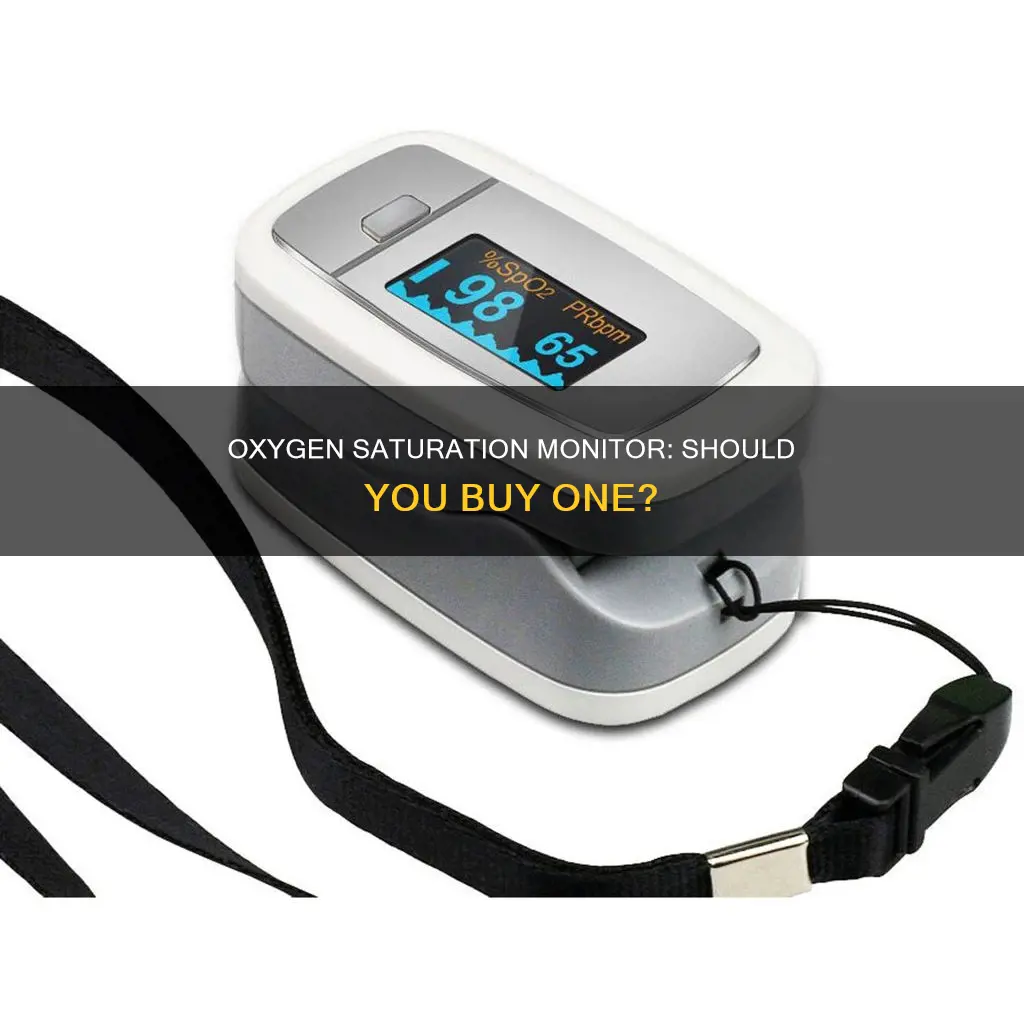
Pulse oximeters are devices that can be clipped onto a person's finger to measure their heart rate and oxygen saturation in the blood. They are especially useful for people with underlying respiratory and heart conditions, as well as those with COVID-19, to monitor their oxygen levels. While pulse oximeters can be helpful in detecting low oxygen levels, which may be a sign of a serious health issue, they are not always accurate and should not be solely relied upon for a health diagnosis. When considering whether to buy a pulse oximeter, it is important to weigh the benefits and limitations of these devices and consult with a medical professional for guidance.
| Characteristics | Values |
|---|---|
| Purpose | Measures blood oxygen levels and heart rate |
| Use cases | Useful for people with underlying respiratory and heart conditions, or if you have COVID-19 |
| Normal range | 95% to 99% |
| When to see a doctor | If your oxygen level falls below 90%, contact your doctor immediately. If it's below 92%, go to the emergency room. |
| Accuracy | Most at-home pulse oximeters provide accurate readings, but accuracy can be influenced by factors such as nail polish, skin colour, low body temperature, and intravascular dyes. |
| Display | Look for a clear and simple display with large, bright numbers that are easy to read. |
| Fit | Ensure the oximeter fits your finger comfortably and securely without pinching or chafing the skin. |
| Portability | Consider a lightweight device with a carrying case or lanyard for easy transport. |
| Power source | Most pulse oximeters are powered by AAA batteries, but some have rechargeable lithium batteries. |
| Additional features | Some oximeters offer app connectivity, alarms, and adjustable display orientations. |
What You'll Learn

Accuracy of pulse oximeters
Pulse oximeters are small, painless devices that can be used to measure blood oxygen saturation levels. They are typically clipped onto a person's fingertip, and they send beams of red and infrared light through the tissues to estimate oxygen saturation. Oxygen saturation levels can be a sign of how well a person's lungs are working. Normal blood oxygen saturation levels are between 95% and 100%, and levels below 90% may indicate hypoxemia, a condition where the body lacks oxygen.
The accuracy of pulse oximeters can be affected by various factors, including skin pigmentation, fingernail polish, skin temperature, and intravenous dyes. Recent studies have suggested that pulse oximeters may be less accurate for individuals with darker skin tones due to the absorption of light by melanin. The U.S. Food and Drug Administration (FDA) categorizes pulse oximeters into two types: prescription oximeters and over-the-counter oximeters.
Prescription oximeters have been vetted by the FDA and are clinically tested for accuracy. They are typically used in medical settings but can also be prescribed for at-home use. Over-the-counter oximeters, on the other hand, are sold directly to consumers and are not reviewed by the FDA. These devices are intended for general wellness or fitness purposes and should not be used for medical decisions.
To ensure accurate readings, it is important to follow the manufacturer's instructions and ensure that the hand is warm, relaxed, and resting below the heart. Additionally, any fingernail polish or artificial nails should be removed before taking a reading.
When interpreting pulse oximeter readings, it is important to consider other symptoms and trends over time. A reading below 92% may indicate potential hypoxemia, but this should be evaluated in conjunction with other factors such as shortness of breath or chest pain.
In summary, pulse oximeters can be a useful tool for monitoring blood oxygen saturation levels, but their accuracy can be influenced by various factors, and they should not be solely relied upon for medical diagnoses.
Identifying LCD Monitors: A Quick Guide to Knowing Yours
You may want to see also

When to use a pulse oximeter
Pulse oximeters are a quick, easy, and painless way to check your blood oxygen levels. They are especially useful for people with respiratory or cardiovascular conditions, such as asthma, COPD, or congestive heart failure. They can also be useful for athletes or people living at high altitudes.
- When you are sick: If you are recovering from an illness, such as COVID-19 or pneumonia, a pulse oximeter can help you monitor your oxygen levels and pulse rate. If your oxygen level drops below 95%, or if you experience other symptoms such as shortness of breath or chest pain, it is important to seek medical care.
- When you have a chronic condition: If you have a chronic respiratory or heart condition that affects your oxygen saturation, a pulse oximeter can help you manage your condition at home. For example, if you have COPD or interstitial pulmonary fibrosis, a pulse oximeter can alert you when your oxygen saturation has dipped below a healthy level.
- When you are at high altitudes: If you are travelling to high altitudes, your blood oxygen levels may drop. A pulse oximeter can help you monitor your oxygen saturation and alert you if it drops too low.
- When you are an athlete: Athletes can use pulse oximeters to track their oxygen saturation and heart rate during workouts or high-intensity activities.
- When you are a pilot: Pilots can use pulse oximeters to monitor their oxygen saturation during flights.
- When you want to track your health: Pulse oximeters can be used to track your health trends over time. This can be especially useful if you have a health condition that affects your oxygen saturation.
- When you are experiencing symptoms: If you are experiencing symptoms such as shortness of breath, rapid breathing, confusion, or chest pain, a pulse oximeter can help determine if your oxygen saturation levels are within a healthy range.
Removing FPS Counter: ASUS VG245H Monitor Guide
You may want to see also

Types of pulse oximeters
Pulse oximeters are available in various types, including fingertip, wrist-worn, and sleep trackers. Here is a detailed overview of each type:
Fingertip Pulse Oximeters
Fingertip pulse oximeters are the most popular type and typically clip onto your finger like a clothespin. They are compact, portable, and relatively inexpensive compared to other types. Some models come with a lanyard or carrying case, making them convenient to carry around. Fingertip pulse oximeters are easy to use and provide quick results, making them a good option for spot-checking blood oxygen saturation at home.
Wrist Pulse Oximeters
Wrist pulse oximeters are designed to be worn on the wrist like a watch. They feature a sensor on the back that measures the oxygen level in the blood. While they can be more comfortable than fingertip models, they may have a higher margin of error. Wrist pulse oximeters are ideal for those who want a more comfortable option and don't require the highest level of accuracy.
Sleep Trackers
Sleep trackers are worn on the base of the finger or fingertip and continuously monitor oxygen saturation and heart rate during sleep. They often come with a companion app that tracks sleep quality and provides personalized tips for improving sleep. Sleep trackers are ideal for people who want to monitor their oxygen levels and heart rate while they sleep, such as those with sleep disorders like obstructive sleep apnea.
Other Types
In addition to the three main types mentioned above, there are also some unique variations of pulse oximeters available. For example, the Wellue Viatom O2Ring is a wearable monitor that fits on your finger like a ring. It continuously monitors oxygen saturation and heart rate and can be worn during sleep or exercise. There are also smartphone app-connected pulse oximeters, such as the iHealth Wireless Pulse Oximeter, which allow for data tracking and sharing with healthcare providers.
Monitors for Stock Trading: Size and Display Quality Matters
You may want to see also

How to read pulse oximeter results
Pulse oximeters are a quick, easy, and painless way to check your blood oxygen levels. They are especially useful for those with respiratory or cardiovascular conditions. Here is a step-by-step guide on how to read pulse oximeter results:
Step 1: Prepare the Device
Before taking a reading, ensure that your hands are warm and that your fingernails are clean and dry. Remove any nail polish, acrylics, or artificial nails, as these can interfere with the reading.
Step 2: Position Your Hand
Find a comfortable position and rest for at least five minutes before taking a reading. This will ensure that you are relaxed and that your hand is still.
Step 3: Place the Oximeter on Your Finger
Place the oximeter on the fingertip of your index or middle finger. These fingers are recommended because they receive more blood flow than the ring and pinky fingers. The oximeter should feel snug but comfortable.
Step 4: Wait for the Reading
Keep your hand still for at least one minute. If the numbers keep fluctuating, you may need to wait longer. Once the numbers stabilize, you have your reading.
Step 5: Record the Results
You will see two numbers on the display. One is your oxygen saturation level, and the other is your heart rate. Each will be clearly labeled. Write down both numbers or take a picture of the display for future reference.
Step 6: Remove the Device
Once you have your reading, remove the oximeter from your finger and store it in a safe place.
Step 7: Track Your Readings
It is helpful to track your oxygen saturation levels over time. You can record your readings in a dedicated notebook or use an app on your smartphone or tablet. This information can be valuable for your healthcare provider and can help them provide more accurate care.
It is important to note that pulse oximeters may not be equally accurate for all skin tones. Recent studies have found racial bias in oximeter readings, with people of darker skin tones sometimes receiving less accurate results. Therefore, it is crucial to be aware of this limitation and consult a healthcare professional if you have any concerns.
Why G-Sync Monitors are Worth the Investment
You may want to see also

Signs of low blood oxygen levels
Low blood oxygen levels, also known as hypoxemia, occur when the body is unable to deliver sufficient oxygen to its cells, tissues, and organs. This can be due to insufficient oxygen in the air, an inability of the lungs to inhale and send oxygen to cells and tissues, or poor circulation.
Changes in Skin Colour
One of the most noticeable signs of low blood oxygen is a change in skin colour, which can range from blue to cherry red. This is often most visible on the lips or face, giving them a blue tint or a dusky appearance.
Shortness of Breath
People with low blood oxygen levels may experience shortness of breath, especially during physical activity or when at rest. This can be a severe and sudden onset or a gradual worsening of breathlessness.
Dizziness and Lack of Coordination
Hypoxemia can cause dizziness and a lack of coordination, which may lead to falls or accidents.
Irritability and Confusion
Low blood oxygen levels can affect cognitive function, leading to irritability, confusion, or changes in mental status.
Rapid or Irregular Heartbeat
A rapid or irregular heartbeat, also known as arrhythmia, is another sign of hypoxemia. This can be felt as a fluttering or pounding sensation in the chest.
It is important to note that these symptoms can vary from person to person and may be subtle in the early stages of low blood oxygen levels. However, if you experience any of these symptoms, it is crucial to seek medical attention promptly, as low blood oxygen levels can be life-threatening if left untreated.
Monitoring GPU Usage: A Comprehensive Guide to Tracking Performance
You may want to see also
Frequently asked questions
An oxygen saturation monitor, or pulse oximeter, is a device used to measure the body's heart rate and oxygen levels. It does so by sending small beams of light through your finger to track the amount of oxygen in your blood.
People with underlying respiratory and heart conditions, such as asthma, pneumonia, and chronic obstructive pulmonary disease (COPD), may find it helpful to use an oxygen saturation monitor. Additionally, those with COVID-19 can use it to monitor their oxygen levels, as low oxygen saturation levels can be a sign of the virus.
A normal oxygen saturation level, or SpO2, typically falls within the range of 95% to 100%. A reading under 90% is considered dangerously low and requires immediate medical attention.
Yes, several factors can impact the accuracy of oxygen saturation readings. These include nail polish, especially in darker colours, cold hands, low body temperature, and thick fingernails. Additionally, skin pigmentation can also affect the accuracy of readings, with darker skin tones potentially interfering with the light of the monitor.







